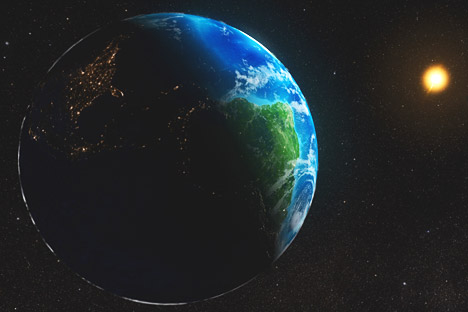Russia and the U.S. to study solar activity

Russia and the U.S. to work together studying solar storms and radiation belts. Source: NASA / Press Photo
Russia is preparing to implement its Intergelio-Zond project, which is being developed by researchers at the Space Research Institute (SRI) of the Russian Academy of Sciences. The space vehicle, which is projected to launch in 2018, will enable scientists to get closer to the Sun than ever before. The project is currently in the research stage.
Sunspots appear
In September 2009, the American GOES meteorological system detected unusually high solar intensity at the X-ray range, after astronomers had discovered two bright regions on the Sun. The spots appeared almost simultaneously and quite far from one another, suggesting global consequences for changes in solar activity.
“The vehicle will be sent close to the Sun with the help of a gravity-assist manoeuver near Venus,” said SRI Director Lev Zelyony. “It will be delivered into orbit with a perihelion of 42 million kilometers (26 million miles). The perihelion may be eventually halved to 21 million kilometers (13 million miles), following other gravity-assist maneuvers that make it possible to monitor the same areas of the surface of the Sun for longer periods of time – up to seven days.”
“The module may descend even closer to the Sun: its minimum altitude will be limited only by the evaporation of the protective screen caused by solar emission. This will give the vehicle its own ‘atmosphere’ that will distort measurements.”
Radiation belts
The Earth is surrounded by two layers of radiation belts. The first layer extends from about 995 to 8100 miles above the Earth’s surface. The second belt starts slightly higher than 9300 miles and extends 13,000 miles above the surface. Solar activity causes the belts to expand, reaching an altitude of only 130 miles from the surface and threatening the work of the ISS and satellites.
Furthermore, the SRI and the Institute of Terrestial Magnetism, Ionosphere and Radio Wave Propagation (IZMIRAN) are developing a solar wind-monitoring system to ensure high-precision forecasts of magnetic storms 1.5–2 hours before they hit Earth. Chibis micro-satellites will be the key component of the system, according to IZMIRAN Director Vladimir Kuznetsov. The first 90-pound Chibis was delivered from the International Space Station (ISS) to low-earth orbit on January 25, 2012.
Russian space initiatives will be coordinated with a corresponding NASA Living with a Star program. The objective of the program is to study radiation belts – the rings of high-energy particles surrounding the Earth. These radiation rings, which became one of the first American space-age discoveries, depend on solar activity and space weather created by the Sun. Pilots and astronauts run the risk of exposure to dangerous radiation levels during periods of violent activity. The radiation belts are also capable of disturbing the operation of satellites and communication systems.
Magnetic storms
The strongest solar storm ever was registered took place on August 28, 185 – measurement readings were off the scale. The storm caused a collapse of the telegraph system, which suffered a damaging voltage spike.
Storms of this scale only happen once every 500 years, but other storms half as strong take place every 50 years. The most recent of the “weaker” storms occurred on Nov. 13, 1960 and resulted in geomagnetic field disturbances that impeded the operation of radio stations. An even weaker solar storm caused an accident at a hydroplant in Quebec, leaving 6 million people without power.“We still don’t understand how the belts behave, more than 50 years after they were first recognized and described,” said Lika Guhathakurta, a NASA program scientist. “Nor do we have the ability to make any predictions, which is really very important.”
When the first astronomical measuring instruments were developed nearly 440 years ago, it became clear that the Sun affects all processes happening on earth. Solar activity – flares, magnetic storms and fire outbursts – can vary in intensity from hardly perceptible to powerful storms. The world’s reliance on radio-electronic devices is so significant that intense solar activity could disturb the operation of life-supporting systems around the globe.
Poor space weather is also known to impede the work of all orbital systems. The U.S. Department of Defense has estimated that space weather disruptions to government satellites add up to nearly $100 million each year. In 1996–2005, insurance companies paid about $2 billion to cover damages and losses of space vehicles caused by solar activity.
The American continent is most vulnerable to fierce solar storms because of its proximity to the north magnetic pole. According to a study by MetaTech Corporation, if a storm with strength comparative to the one that came in 1859 were to strike today, the entire power grid of North America would break down and operations to restore the energy supply could only be started a few weeks after the event.
All rights reserved by Rossiyskaya Gazeta.
Subscribe
to our newsletter!
Get the week's best stories straight to your inbox